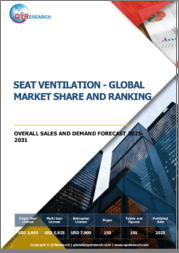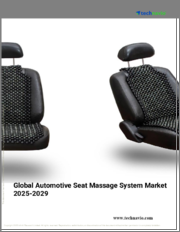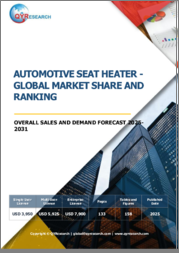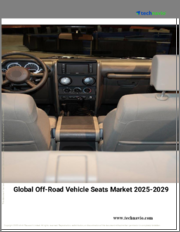
|
시장보고서
상품코드
1460723
세계의 자동차용 전동 시트 시장 : 시장 규모 및 점유율 분석 - 동향, 촉진요인, 경쟁 상황, 예측(2024-2030년)Automotive Electric Seats Market Size & Share Analysis - Trends, Drivers, Competitive Landscape, and Forecasts (2024-2030) |
||||||
자동차 전동 시트 시장은 지속적으로 성장하고 있으며, 2030년에는 953억 달러에 달할 것으로 예상됩니다. 그 배경에는 운전 중 편의성에 대한 니즈 증가와 기술 발전이 있습니다.
2023년에는 승용차 부문이 업계에서 가장 큰 점유율을 차지하며 약 50%를 차지했습니다.
2023년 표준 동력 시트는 업계에서 35% 점유율을 차지했습니다.
이러한 시트는 높은 수준의 안전성과 사용 편의성을 갖추고 있어 대부분의 자동차 소유주에게 기본적이고 유리한 선택이 되고 있습니다.
2023년에는 운전석 시트가 45%의 업계 점유율을 차지하며 운전자의 편안함과 안전을 우선시하고 있습니다.
2023년 아시아태평양은 특히 중국, 인도, 한국의 급속한 산업화로 인해 자동차 전동 시트 산업을 주도했습니다.
아시아태평양은 트럭과 버스의 안락함을 추구하는 소비자의 수요에 따라 전동 시트의 사용이 확대되면서 가장 높은 성장률(CAGR 6.2%)을 보일 것으로 예상됩니다.
세계의 자동차용 전동 시트 시장을 분석했으며, 시장의 기본 구조와 최신 상황, 주요 촉진·억제요인, 세계 전체 및 지역별·주요 국가별 시장 규모 동향 전망(금액 기준, 2017-2030년), 유통 채널별·차종별·기술별·시트 유형별·용도별 상세 동향, 현재 시장 경쟁 상황, 주요 기업 개요 등을 조사하여 전해드립니다.
목차
제1장 조사 범위
제2장 조사 방법
제3장 주요 요약
제4장 시장 지표
제5장 업계 전망
- 시장 역학
- 동향
- 성장 촉진요인
- 성장 억제요인/과제
- 성장 촉진요인/억제요인의 영향 분석
- 신종 코로나바이러스 감염증(COVID-19)의 영향
- Porter's Five Forces 분석
제6장 세계 시장
- 개요
- 시장 매출 : 유통 채널별(2017-2030년)
- 시장 매출 : 차종별(2017-2030년)
- 시장 매출 : 기술별(2017-2030년)
- 시장 매출 : 좌석 종류별(2017-2030년)
- 시장 매출 : 지역별(2017-2030년)
제7장 북미 시장
- 개요
- 시장 매출 : 유통 채널별(2017-2030년)
- 시장 매출 : 차종별(2017-2030년)
- 시장 매출 : 기술별(2017-2030년)
- 시장 매출 : 좌석 종류별(2017-2030년)
- 시장 매출 : 국가별(2017-2030년)
제8장 유럽 시장
제9장 아시아태평양 시장
제10장 라틴아메리카 시장
제11장 중동 및 아프리카(MEA) 시장
제12장 미국 시장
- 개요
- 시장 매출 : 유통 채널별(2017-2030년)
- 시장 매출 : 차종별(2017-2030년)
- 시장 매출 : 기술별(2017-2030년)
- 시장 매출 : 좌석 종류별(2017-2030년)
제13장 캐나다 시장
제14장 독일 시장
제15장 프랑스 시장
제16장 영국 시장
제17장 이탈리아 시장
제18장 스페인 시장
제19장 일본 시장
제20장 중국 시장
제21장 인도 시장
제22장 호주 시장
제23장 한국 시장
제24장 브라질 시장
제25장 멕시코 시장
제26장 사우디아라비아 시장
제27장 남아프리카공화국 시장
제28장 아랍에미리트(UAE) 시장
제29장 경쟁 상황
- 시장 진출 기업과 그 제공 제품/서비스 리스트
- 주요 기업 경쟁 벤치마크
- 주요 기업의 제품 벤치마크
- 최근의 전략 전개 상황
제30장 기업 개요
- Lear Corporation
- Delphi Powertrain Systems Operations Luxembourg S. a r.l.
- Faurecia SE
- TOYOTA BOSHOKU CORPORATION
- Johnson Controls
- Omron Electronics LLC
- Tokai Rika Co. Ltd.
- Marquardt Management SE
- Yanfeng
- Shuanglin Group Co. Ltd.
- Magna International Inc.
제31장 부록
ksm 24.04.22The automotive electric seat market is experiencing growth and is projected to reach USD 95.3 billion by 2030. This can be credited to the increasing need for ease while driving and technical improvement.
It will increase the demand for autonomous vehicles that with stem the improvement in passenger convenience. The added luxury of installed electric seats gives the additional flexibility of both personal settings, as well as minor adjustments.
This allows passengers to stand, sit back, or lean against anything they please. This feature becomes more significant when you have an opportunity to do your work or even take a nap as the vehicle is controlled by itself.
The design of the inside space of the vehicle, driverless type, will be different from the layout of the inside view of the traditional vehicles. For example, autonomous vehicles normally use seats that can swivel or lean back for passengers, while the passengers in traditional cars continue to maintain a sitting position with their seats settled straight. The growing demand for seats that can be used in outside shop areas, leads to a boom in sales of seating products, all over the globe.
Integrated seats are comfortable because of their use of electric technologies rather than the historic mechanical seats. They offer these chairs with a variety of elements like under-hip support, lower-back tilt, headrests, and massage. Because of these advantages, the user can find himself in his best driving and riding position which is associated with the utmost comfortableness.
Key Insights
In 2023, the passenger cars category had the largest industry share, of approximately 50%.
This is mainly because increasing sale of cars as individuals seek personal mobility.
Passenger cars are the key means of transport for persons and families, because of which their sales continue to advance.
In 2023, standard-powered seats held a 35% industry share because of their extensive use in everyday transport.
Such seats have advanced security and ease, being the basic and lucrative choices for most vehicle owners.
Heating, ventilation, massage, and memory seats are projected to advance at a 6.0% CAGR because of their added features such as warming elements, massaging abilities, and memory settings for user ease.
Such enhanced seat categories provide advanced ease and convenience during lengthy drives and opposing weather conditions.
In 2023, the driver seats held a 45% industry share, prioritized for the driver's ease and security.
Electric driver seats provide adaptable support, heating, ventilation, massage, and memory settings.
Such features advance driver ease, security, and total driving experience.
Dual seats rank second in industry share, generally utilized in passenger cars and certain commercial vehicles.
In 2023, the APAC region led the automotive electric seats industry because of quick industrialization, particularly in China, India, and South Korea.
Low labor and raw material prices in APAC make the industry lucrative, directing to enhanced features in vehicles at competitive costs.
The government policies put in force by developing nations like India and China have a positive influence on industrial growth and attract foreign investors which in turn boost the automotive sector.
APAC is expected to have the highest level of growth (CAGR of 6.2%) as the use of electric seats has expanded in line with the consumer demand for the comfort of trucks and buses.
Table of Contents
Chapter 1. Research Scope
- 1.1. Research Objectives
- 1.2. Market Definition
- 1.3. Analysis Period
- 1.4. Market Size Breakdown by Segments
- 1.4.1. Market size breakdown, by distribution channel
- 1.4.2. Market size breakdown, by vehicle type
- 1.4.3. Market size breakdown, by technology
- 1.4.4. Market size breakdown, by seat type
- 1.4.5. Market size breakdown, by region
- 1.4.6. Market size breakdown, by country
- 1.5. Market Data Reporting Unit
- 1.5.1. Value
- 1.6. Key Stakeholders
Chapter 2. Research Methodology
- 2.1. Secondary Research
- 2.1.1. Paid
- 2.1.2. Unpaid
- 2.1.3. P&S Intelligence database
- 2.2. Primary Research
- 2.3. Market Size Estimation
- 2.4. Data Triangulation
- 2.5. Currency Conversion Rates
- 2.6. Assumptions for the Study
- 2.7. Notes and Caveats
Chapter 3. Executive Summary
Chapter 4. Market Indicators
Chapter 5. Industry Outlook
- 5.1. Market Dynamics
- 5.1.1. Trends
- 5.1.2. Drivers
- 5.1.3. Restraints/challenges
- 5.1.4. Impact analysis of drivers/restraints
- 5.2. Impact of COVID-19
- 5.3. Porter's Five Forces Analysis
- 5.3.1. Bargaining power of buyers
- 5.3.2. Bargaining power of suppliers
- 5.3.3. Threat of new entrants
- 5.3.4. Intensity of rivalry
- 5.3.5. Threat of substitutes
Chapter 6. Global Market
- 6.1. Overview
- 6.2. Market Revenue, by Distribution Channel (2017-2030)
- 6.3. Market Revenue, by Vehicle Type (2017-2030)
- 6.4. Market Revenue, by Technology (2017-2030)
- 6.5. Market Revenue, by Seat Type (2017-2030)
- 6.6. Market Revenue, by Region (2017-2030)
Chapter 7. North America Market
- 7.1. Overview
- 7.2. Market Revenue, by Distribution Channel (2017-2030)
- 7.3. Market Revenue, by Vehicle Type (2017-2030)
- 7.4. Market Revenue, by Technology (2017-2030)
- 7.5. Market Revenue, by Seat Type (2017-2030)
- 7.6. Market Revenue, by Country (2017-2030)
Chapter 8. Europe Market
- 8.1. Overview
- 8.2. Market Revenue, by Distribution Channel (2017-2030)
- 8.3. Market Revenue, by Vehicle Type (2017-2030)
- 8.4. Market Revenue, by Technology (2017-2030)
- 8.5. Market Revenue, by Seat Type (2017-2030)
- 8.6. Market Revenue, by Country (2017-2030)
Chapter 9. APAC Market
- 9.1. Overview
- 9.2. Market Revenue, by Distribution Channel (2017-2030)
- 9.3. Market Revenue, by Vehicle Type (2017-2030)
- 9.4. Market Revenue, by Technology (2017-2030)
- 9.5. Market Revenue, by Seat Type (2017-2030)
- 9.6. Market Revenue, by Country (2017-2030)
Chapter 10. LATAM Market
- 10.1. Overview
- 10.2. Market Revenue, by Distribution Channel (2017-2030)
- 10.3. Market Revenue, by Vehicle Type (2017-2030)
- 10.4. Market Revenue, by Technology (2017-2030)
- 10.5. Market Revenue, by Seat Type (2017-2030)
- 10.6. Market Revenue, by Country (2017-2030)
Chapter 11. MEA Market
- 11.1. Overview
- 11.2. Market Revenue, by Distribution Channel (2017-2030)
- 11.3. Market Revenue, by Vehicle Type (2017-2030)
- 11.4. Market Revenue, by Technology (2017-2030)
- 11.5. Market Revenue, by Seat Type (2017-2030)
- 11.6. Market Revenue, by Country (2017-2030)
Chapter 12. U.S. Market
- 12.1. Overview
- 12.2. Market Revenue, by Distribution Channel (2017-2030)
- 12.3. Market Revenue, by Vehicle Type (2017-2030)
- 12.4. Market Revenue, by Technology (2017-2030)
- 12.5. Market Revenue, by Seat Type (2017-2030)
Chapter 13. Canada Market
- 13.1. Overview
- 13.2. Market Revenue, by Distribution Channel (2017-2030)
- 13.3. Market Revenue, by Vehicle Type (2017-2030)
- 13.4. Market Revenue, by Technology (2017-2030)
- 13.5. Market Revenue, by Seat Type (2017-2030)
Chapter 14. Germany Market
- 14.1. Overview
- 14.2. Market Revenue, by Distribution Channel (2017-2030)
- 14.3. Market Revenue, by Vehicle Type (2017-2030)
- 14.4. Market Revenue, by Technology (2017-2030)
- 14.5. Market Revenue, by Seat Type (2017-2030)
Chapter 15. France Market
- 15.1. Overview
- 15.2. Market Revenue, by Distribution Channel (2017-2030)
- 15.3. Market Revenue, by Vehicle Type (2017-2030)
- 15.4. Market Revenue, by Technology (2017-2030)
- 15.5. Market Revenue, by Seat Type (2017-2030)
Chapter 16. U.K. Market
- 16.1. Overview
- 16.2. Market Revenue, by Distribution Channel (2017-2030)
- 16.3. Market Revenue, by Vehicle Type (2017-2030)
- 16.4. Market Revenue, by Technology (2017-2030)
- 16.5. Market Revenue, by Seat Type (2017-2030)
Chapter 17. Italy Market
- 17.1. Overview
- 17.2. Market Revenue, by Distribution Channel (2017-2030)
- 17.3. Market Revenue, by Vehicle Type (2017-2030)
- 17.4. Market Revenue, by Technology (2017-2030)
- 17.5. Market Revenue, by Seat Type (2017-2030)
Chapter 18. Spain Market
- 18.1. Overview
- 18.2. Market Revenue, by Distribution Channel (2017-2030)
- 18.3. Market Revenue, by Vehicle Type (2017-2030)
- 18.4. Market Revenue, by Technology (2017-2030)
- 18.5. Market Revenue, by Seat Type (2017-2030)
Chapter 19. Japan Market
- 19.1. Overview
- 19.2. Market Revenue, by Distribution Channel (2017-2030)
- 19.3. Market Revenue, by Vehicle Type (2017-2030)
- 19.4. Market Revenue, by Technology (2017-2030)
- 19.5. Market Revenue, by Seat Type (2017-2030)
Chapter 20. China Market
- 20.1. Overview
- 20.2. Market Revenue, by Distribution Channel (2017-2030)
- 20.3. Market Revenue, by Vehicle Type (2017-2030)
- 20.4. Market Revenue, by Technology (2017-2030)
- 20.5. Market Revenue, by Seat Type (2017-2030)
Chapter 21. India Market
- 21.1. Overview
- 21.2. Market Revenue, by Distribution Channel (2017-2030)
- 21.3. Market Revenue, by Vehicle Type (2017-2030)
- 21.4. Market Revenue, by Technology (2017-2030)
- 21.5. Market Revenue, by Seat Type (2017-2030)
Chapter 22. Australia Market
- 22.1. Overview
- 22.2. Market Revenue, by Distribution Channel (2017-2030)
- 22.3. Market Revenue, by Vehicle Type (2017-2030)
- 22.4. Market Revenue, by Technology (2017-2030)
- 22.5. Market Revenue, by Seat Type (2017-2030)
Chapter 23. South Korea Market
- 23.1. Overview
- 23.2. Market Revenue, by Distribution Channel (2017-2030)
- 23.3. Market Revenue, by Vehicle Type (2017-2030)
- 23.4. Market Revenue, by Technology (2017-2030)
- 23.5. Market Revenue, by Seat Type (2017-2030)
Chapter 24. Brazil Market
- 24.1. Overview
- 24.2. Market Revenue, by Distribution Channel (2017-2030)
- 24.3. Market Revenue, by Vehicle Type (2017-2030)
- 24.4. Market Revenue, by Technology (2017-2030)
- 24.5. Market Revenue, by Seat Type (2017-2030)
Chapter 25. Mexico Market
- 25.1. Overview
- 25.2. Market Revenue, by Distribution Channel (2017-2030)
- 25.3. Market Revenue, by Vehicle Type (2017-2030)
- 25.4. Market Revenue, by Technology (2017-2030)
- 25.5. Market Revenue, by Seat Type (2017-2030)
Chapter 26. Saudi Arabia Market
- 26.1. Overview
- 26.2. Market Revenue, by Distribution Channel (2017-2030)
- 26.3. Market Revenue, by Vehicle Type (2017-2030)
- 26.4. Market Revenue, by Technology (2017-2030)
- 26.5. Market Revenue, by Seat Type (2017-2030)
Chapter 27. South Africa Market
- 27.1. Overview
- 27.2. Market Revenue, by Distribution Channel (2017-2030)
- 27.3. Market Revenue, by Vehicle Type (2017-2030)
- 27.4. Market Revenue, by Technology (2017-2030)
- 27.5. Market Revenue, by Seat Type (2017-2030)
Chapter 28. U.A.E. Market
- 28.1. Overview
- 28.2. Market Revenue, by Distribution Channel (2017-2030)
- 28.3. Market Revenue, by Vehicle Type (2017-2030)
- 28.4. Market Revenue, by Technology (2017-2030)
- 28.5. Market Revenue, by Seat Type (2017-2030)
Chapter 29. Competitive Landscape
- 29.1. List of Market Players and their Offerings
- 29.2. Competitive Benchmarking of Key Players
- 29.3. Product Benchmarking of Key Players
- 29.4. Recent Strategic Developments
Chapter 30. Company Profiles
- 30.1. Lear Corporation
- 30.1.1. Business overview
- 30.1.2. Product and service offerings
- 30.1.3. Key financial summary
- 30.2. Delphi Powertrain Systems Operations Luxembourg S. a r.l.
- 30.2.1. Business overview
- 30.2.2. Product and service offerings
- 30.2.3. Key financial summary
- 30.3. Faurecia SE
- 30.3.1. Business overview
- 30.3.2. Product and service offerings
- 30.3.3. Key financial summary
- 30.4. TOYOTA BOSHOKU CORPORATION
- 30.4.1. Business overview
- 30.4.2. Product and service offerings
- 30.4.3. Key financial summary
- 30.5. Johnson Controls
- 30.5.1. Business overview
- 30.5.2. Product and service offerings
- 30.5.3. Key financial summary
- 30.6. Omron Electronics LLC
- 30.6.1. Business overview
- 30.6.2. Product and service offerings
- 30.6.3. Key financial summary
- 30.7. Tokai Rika Co. Ltd.
- 30.7.1. Business overview
- 30.7.2. Product and service offerings
- 30.7.3. Key financial summary
- 30.8. Marquardt Management SE
- 30.8.1. Business overview
- 30.8.2. Product and service offerings
- 30.8.3. Key financial summary
- 30.9. Yanfeng
- 30.9.1. Business overview
- 30.9.2. Product and service offerings
- 30.9.3. Key financial summary
- 30.10. Shuanglin Group Co. Ltd.
- 30.10.1. Business overview
- 30.10.2. Product and service offerings
- 30.10.3. Key financial summary
- 30.11. Magna International Inc.
- 30.11.1. Business overview
- 30.11.2. Product and service offerings
- 30.11.3. Key financial summary
Chapter 31. Appendix
- 31.1. Abbreviations
- 31.2. Sources and References
- 31.3. Related Reports



















